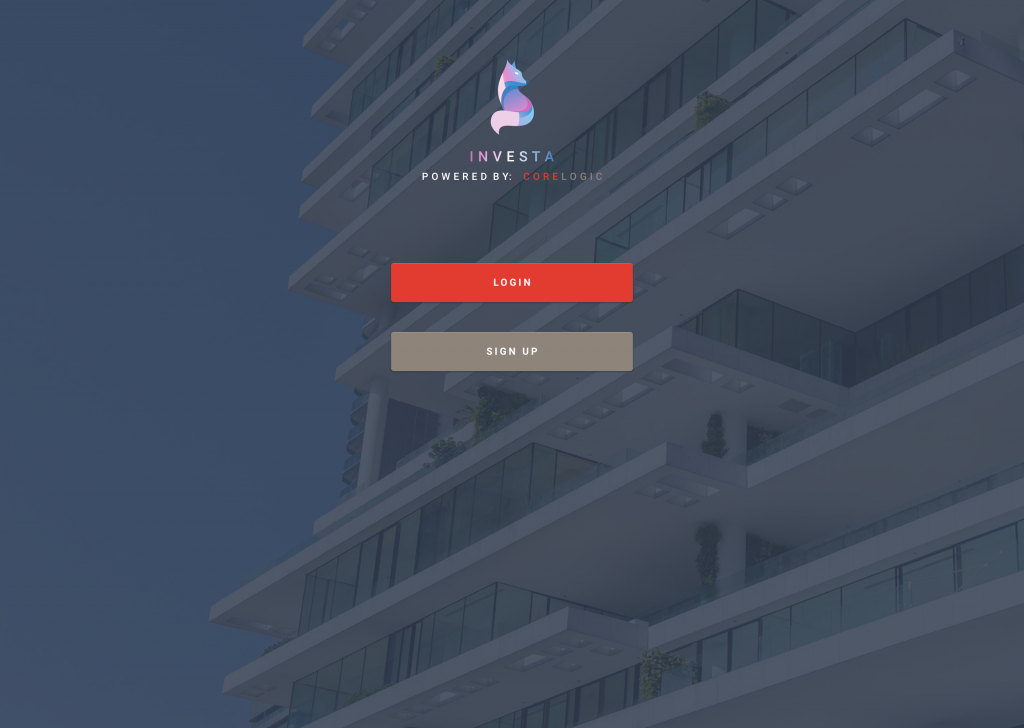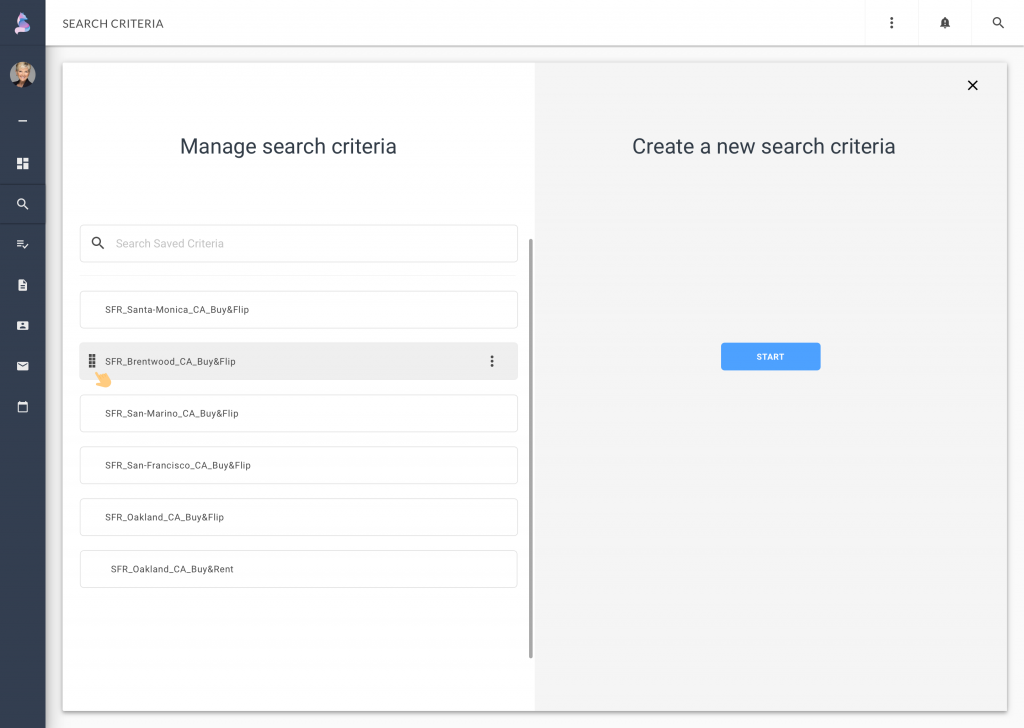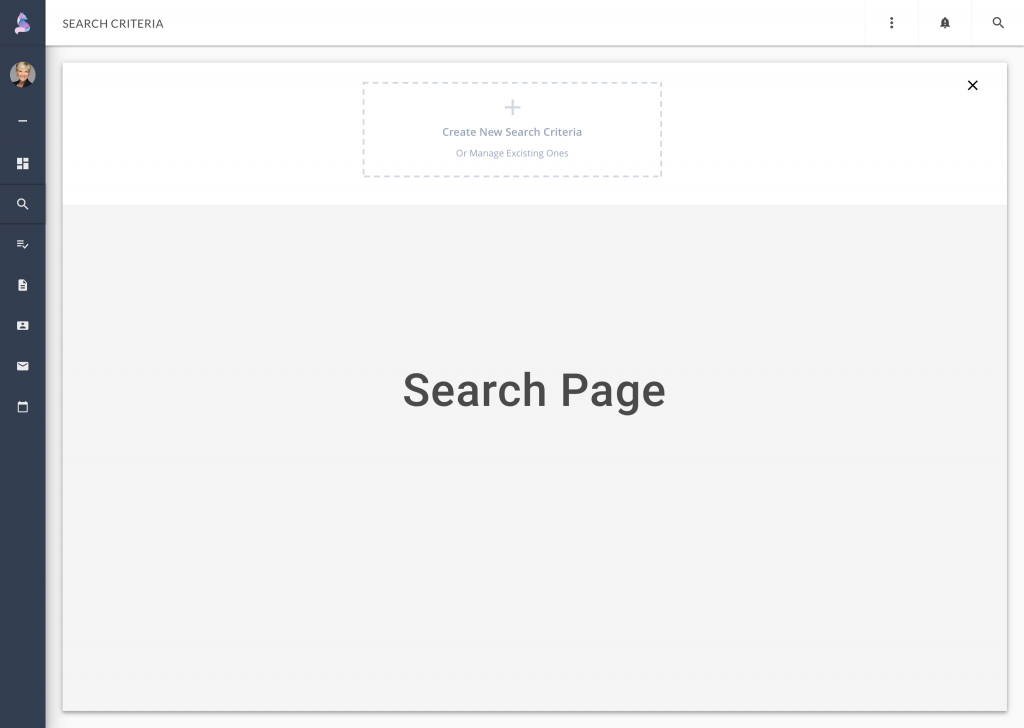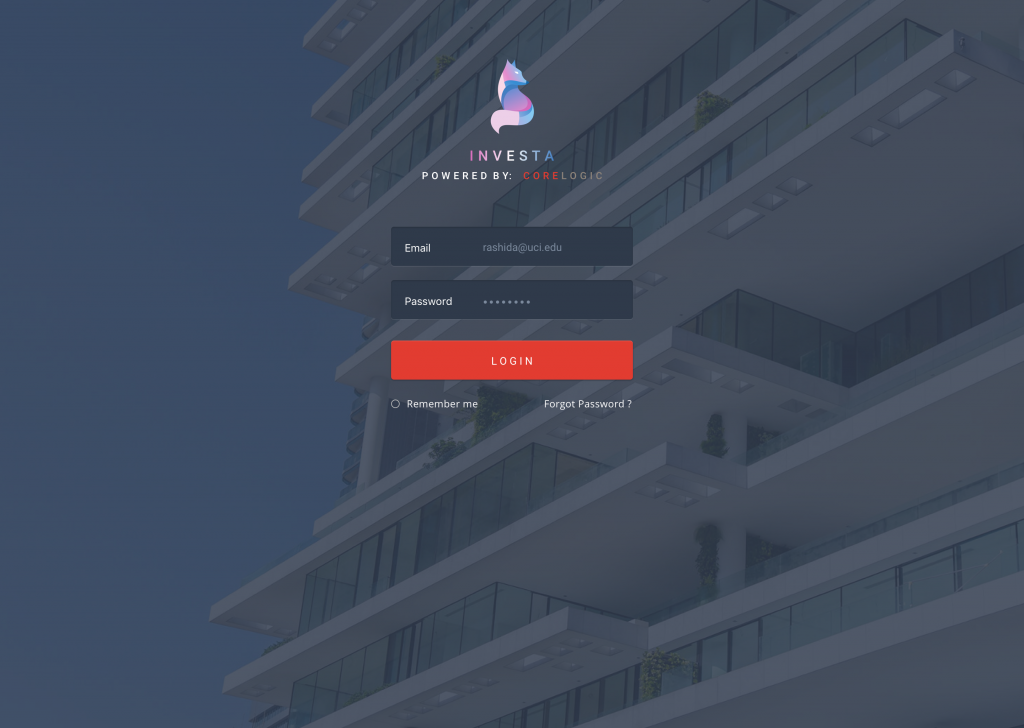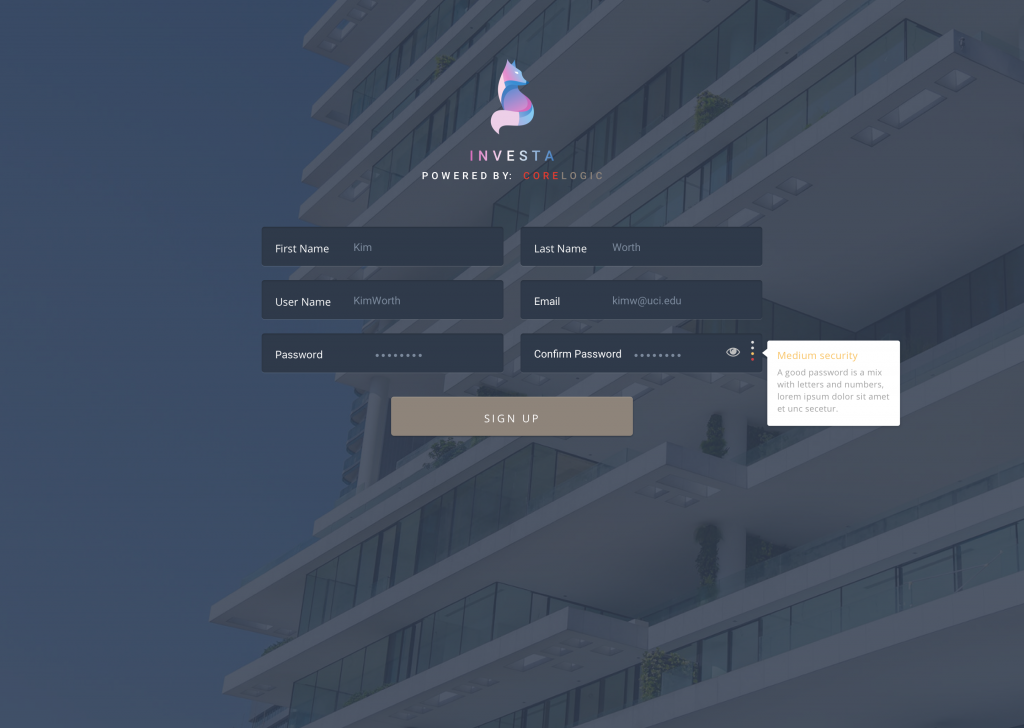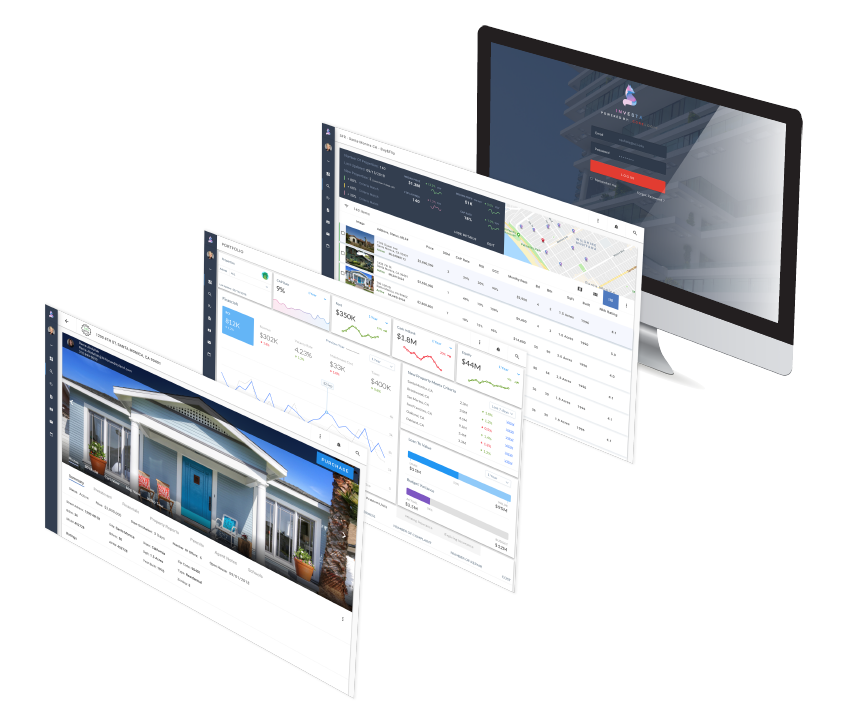INVESTA: Democratizing Real Estate Investments
CoreLogic:
CoreLogic is a global leader in property data, analytics and business intelligence. CoreLogic provides high-quality information to more than 9,000 banks and lenders, over 300 Wall Street firms, and more than 925k real estate professionals.
Essentially, over 50 years, CoreLogic has access to over 4.5 BILLION property records with a 99.5% accuracy.
Problem:
Finding the right properties to invest in is hard, time-consuming, and competitive. There is a lot of information in the world, but how can an investor make sense of it all to make the right decisions, quickly?
Is there an opportunity for CoreLogic to apply it’s high quality data and business intelligence to serving the real estate investment market?
Solution:
Create an easy-to-use software that empowers investors to quickly learn about new properties, take action on properties they’d like to invest in, and manage their real estate investment portfolio.
Date: September 2018
Design Process
we decided to adopt the industry-standard methodology for design process which is the “Double-Diamond” model. This model is a problem-solving approach that starts with divergent thinking (think broadly, keep an open mind, consider anything and everything) followed by convergent thinking (think narrowly, bring back focus and identify one or two key problems and solutions). Below is the list of phases within the double-diamond model and the underlying methods we used.
DISCOVER
Stakeholder Interview
Competitive Analysis
Screener
Survey
Contextual Inquiry
User Interviews
DEFINE
Affinity Diagram
Empathy Map
Personas
Storyboard
User Flow
DEVELOP
Design Sprint Workshop
Sketching
Wireframes
Usability Testing
DELIVER
Prototype
Final Design
Recommendations
Research Overview
During the first ten weeks, we concentrated solely on conducting user research, which consisted of utilizing both quantitative and qualitative techniques. We created a Research Plan that outlined the various methods that will be used during research as well as our objectives for each of the Discover and Define phase. The purpose of the Research Plan was to boil down our collective knowledge, agreements and understanding of what will happen, why, with whom and when.
Objective:
DISCOVER
• Gather information on our target segment for casual and professional real estate investors
• Gather data to understand our opportunity size
• Learn and understand potential key feature sets of the product offering that customers currently have and want. (i.e. what data and analytics does the target segment want to see)
DEFINE
• Turn data into actionable insights
• Define the target segment for casual and professional real estate investors.
• Define the user flow, key feature sets of the product offering. (ie what data and analytics does the target segment want to see)
Competitive Analysis
We conducted a competitive analysis of seven companies in the casual and professional real estate investor market to understand how existing businesses position themselves. The exercise helped identify competitive strengths and weaknesses as well as identify gaps in the existing market for CoreLogic to create unique, relevant value.
DIRECT COMPETITORS
Offer the same or very similar value propositions to current or future customers.



DIRECT COMPETITORS
Target your customer base without offering the same value proposition.


DIRECT COMPETITORS
Any type of business that can help your business to finding innovative insights or relevant UX features that help improvement.

Recommendations
STRATEGY:
● Leverage ecommerce best practices to make data access, display, analysis and management easier and faster to understand.
● Combine property, historical, hazard, local school ratings and market- or sub-market data to give investors holistic view of their properties.
● Design branding, customer service and information display experience to emphasize human, personal element.
● Provide easy-to-read educational elements in a “Resource Center” or “Toolkit” to help different levels of investors deepen their education around full lifecycle of investment - initial investment, portfolio management, rent-to-cost optimization.
● Lean into strength and breadth of partnerships to deliver more comprehensive and useful offering to national customers.
● Capitalize on CoreLogic dominance by launching with nationwide reach.
DESIGN:
● De-stress the research and shopping process with helpful, friendly information tidbits throughout the site.
● Channel ecommerce best practices in Search, Filtering, Favoriting functionality.
● Give users control over how to display their data by offering a “map view” and “list view” with options for users to switch between the two.
● Provide clean labels and tips in your reports.
● Allow users to easily change their search options.
● Add live chat or help center to provide instant support to the users.
Survey
Developed a comprehensive questionnaire with built in logic asking the behavioral patterns of investors while making a new investment. Questions ranging from what analytics, data and tools they use to make these decisions. Had a total of 39 responses.
Survey Takeaways
• Most investors have a high household income level which gives them the financial flexibility to invest in rental properties
• Over 55 % owned more than there rental properties
• Majority of investors utilized outside assistance to find properties (i.e. broker, association/club, friends)
Interviews
We interviewed 9 participants and created a series of standardized list of questions with the following
objectives:
• Gather background on investors (rapport building)
• Understand their business
• High level understanding of their current investment properties
• Ask how they find their properties, process to purchase property, and any post-purchase activities
The most valuable insight we derived from the interview was asking the question:
"If you hand a magic tool to help you buy properties what could this tool do?"
• “One tool where everything is calculated by simply plugging in the address, rent, PITI, and even have a down payment calculator.”
• “Be able to plug the fundamentals of the models and search across MLS listings”
• Better Search Criteria that can be customized by variety of filters (school ratings, crime, occupancy rate, insurance, rent estimates, etc.)
• “Would allow me to expand domain expertise that I have for a few neighborhoods”
• “Would be great to put in my overall criteria; i want to see houses at this price and rent at this price; 4 star better rating in elementary
schools”
• “All-in-one tool that understands how I crunch numbers”
• “See purchase property; knows price point and what I can get rent rate
• “Having the data as up-to-date as possible”
Interview Takeaways
Casual Investor:
• A Lot of reliance on word-of-mouth, human connections, in real life knowledge-sharing and education
• Keep property(ies) for the long haul, will divest for retirement or turn it over to kids; 5-30 year life cycle
• Will often start with a partner or capital from someone else so as to avoid 30 yr loan
• Used the services of a realtor to help locate properties
• Conducted their own market research
• Back up home option
• Small investors like the idea of a consumer website
“I definitely use a realtor and I look at price point 1st”
Professional Investor:
• Larger investor would want info on a region (bulk data on large scale; will make more money on bulk sale); something that is displayed in a user-friendly way
• More available capital, more “burn and turn”; keep assets for 2-5 years before offloading
• Continually purchasing new properties and can pull the trigger within weeks
• Have a set formula on how they evaluate and consider buying a property
• Sometimes never see the property they are purchasing
• Heavily reliant on trust worthy and correct data
“Time is what I value most, find a way to save me time and I’ll use it.”
Making sense of the data
Affinity Diagram
With Affinity Diagramming technique we organized data gathered during the Survey and interview into groups with common themes / relationships and categorize them together, to found patterns and define those insights.
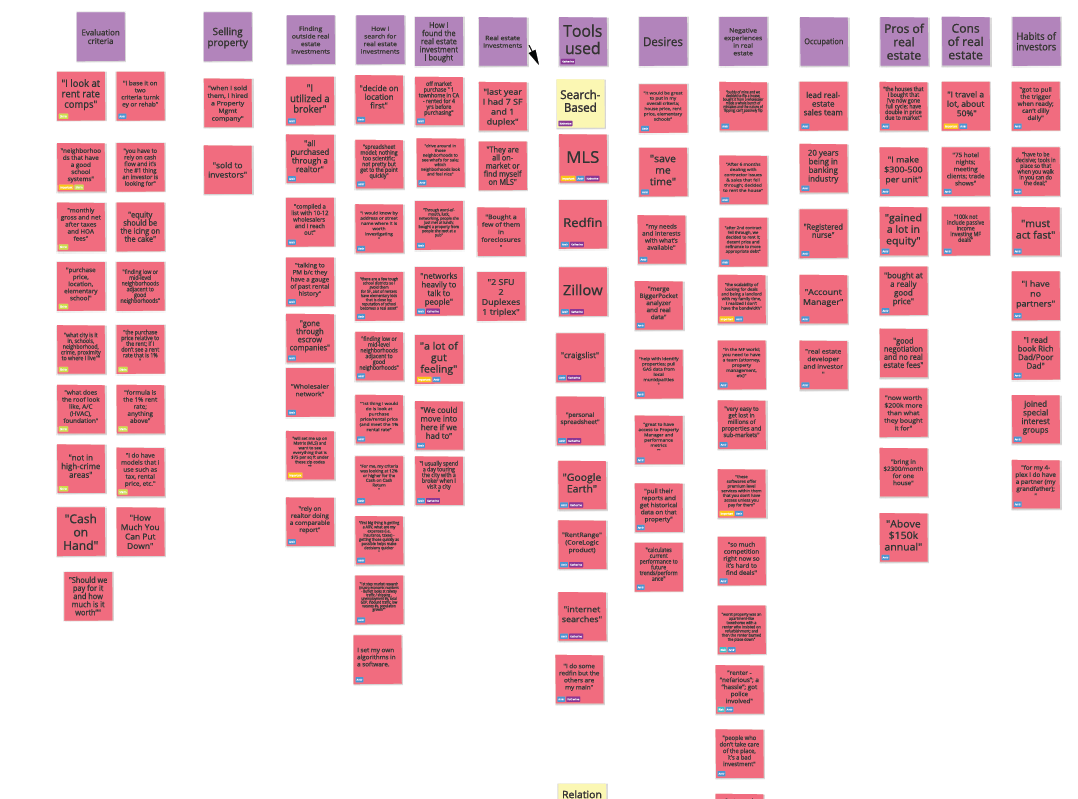
Key Insights
• Majority of investors solicit outside help when discovering investment opportunities
• Similar patterns emerged regarding the criteria for searching properties (i.e. school, crime, rent rate)
• Identified common habits of investors that were critical when purchasing property
Empathy Map
Empathy maps are used to create alignment on the investors needs, goals, and pain points, and bridges the gap between personas and the content we create. Additionally, this process allowed us to consider and examine the target user’s greatest motivations, desires and hurdles when it comes to the future solution, allowing us to make meaningful design decisions.

Key Insights
• Time is the # 1 commodity for investors in making investment purchases
• The desire for accurate and trusted data is critical
• Ability to track and analyze data for informed decision-making
• Over reliance on real estate professionals to provide expertise advice causes frustrations and lack of confidence
Personas
With the extracted data from survey and interview we came up with two personas that helped our team to understand target audience, their expectations, concerns and motivations.
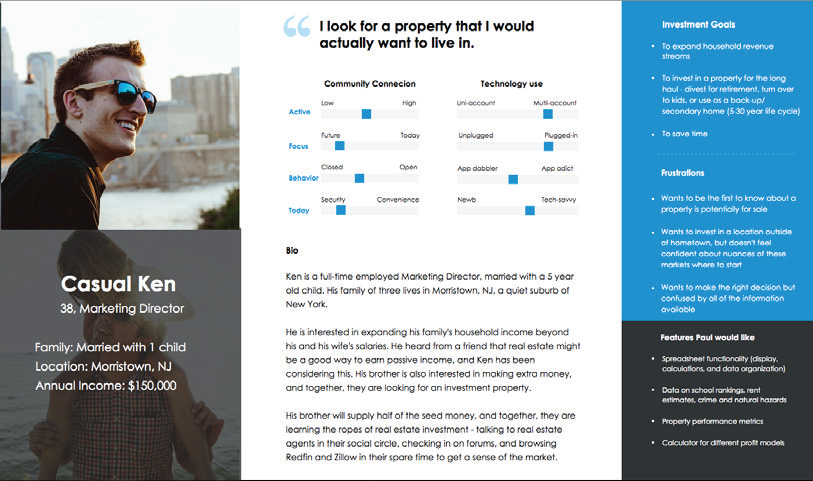
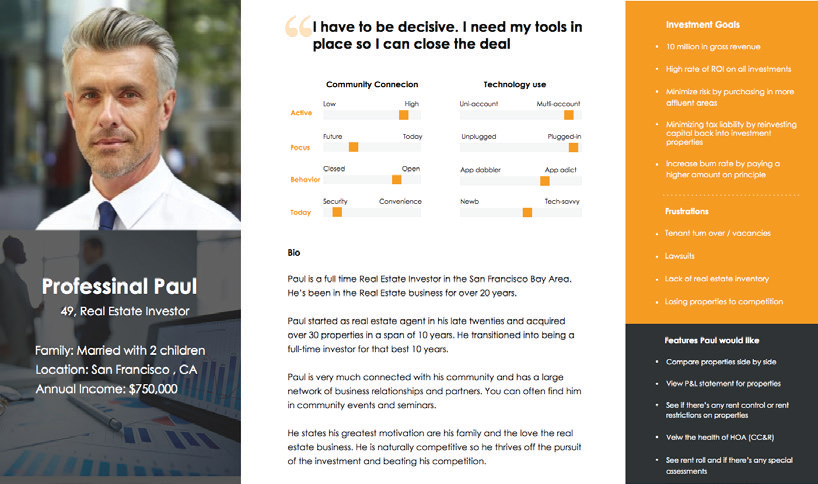
Key Insights
• Both personas share similar traits in that they are tech-savvy, active in their respective communities, and prefer insights into ROI data
• “Speed” is a critical success factor for the professional investor whereas “personal connection” to property is important to the casual investor
• Accurate and timely information is critical when making investment decisions
Storyboard
“A picture is worth a thousand words.” Illustrating a concept or idea helped our team and the client understand our users and added another layer of meaning and significance
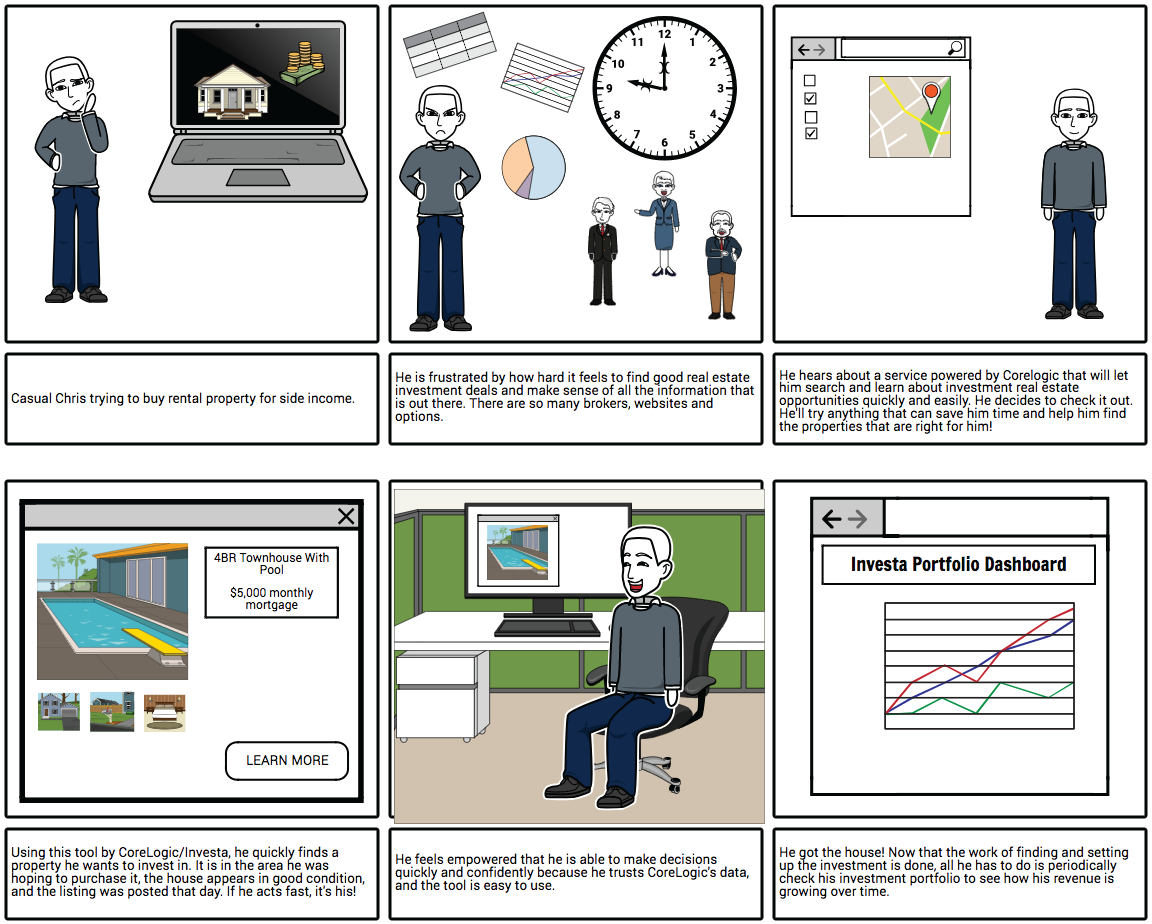
Starting the Design
Based off three months of research, countless stakeholder meetings and a design sprint that defined the user flow - we were ready to put pen to paper. We began dividing up the work by assigning pages of the user flow to each member in the group. We went through a rapid iteration phase while sketching and had share outs several times a week to finalize on what we would create for our low fidelity wireframes. After the low-fi wireframes were created we went through three rounds of iterations based off stakeholder and usability feedback.
Sprint Workshop
The Investa Team met with CoreLogic stakeholders at the headquarters in Irvine, California for a full-day design sprint.
The activities of the day included sketching mockups, and active discussion around the minimum viable product that would achieve CoreLogic’s objective.

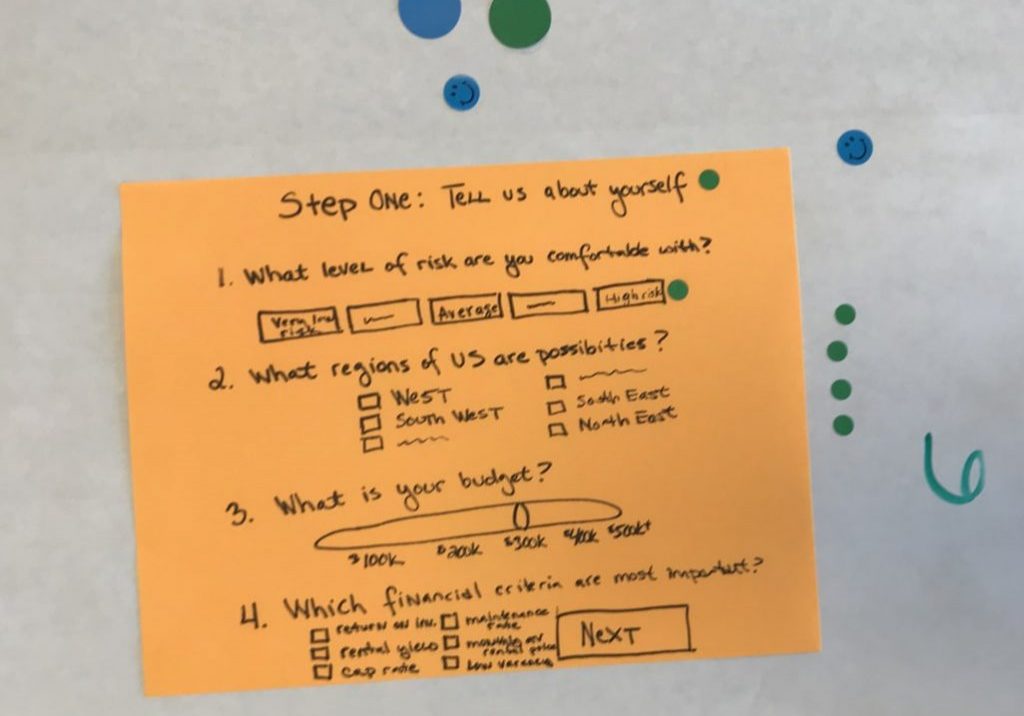
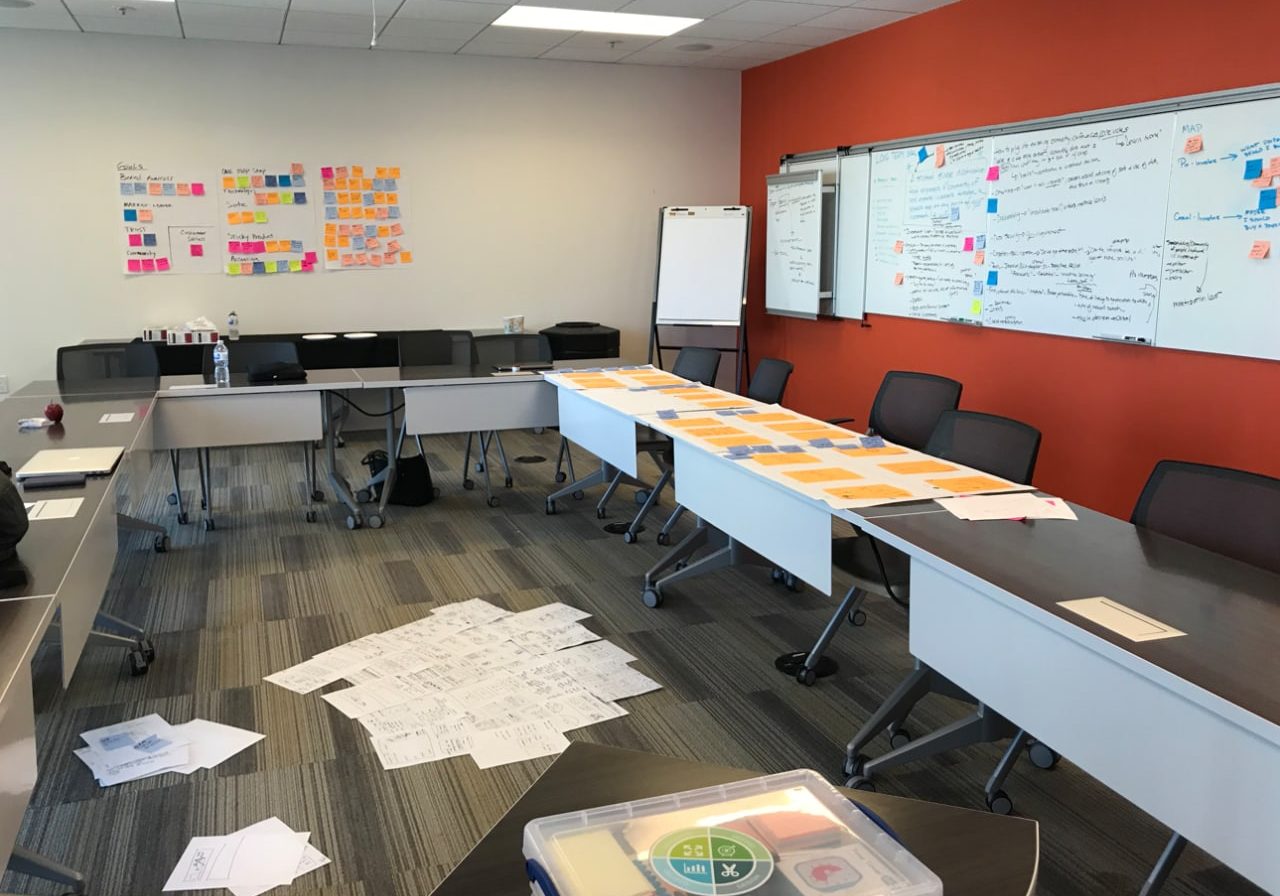

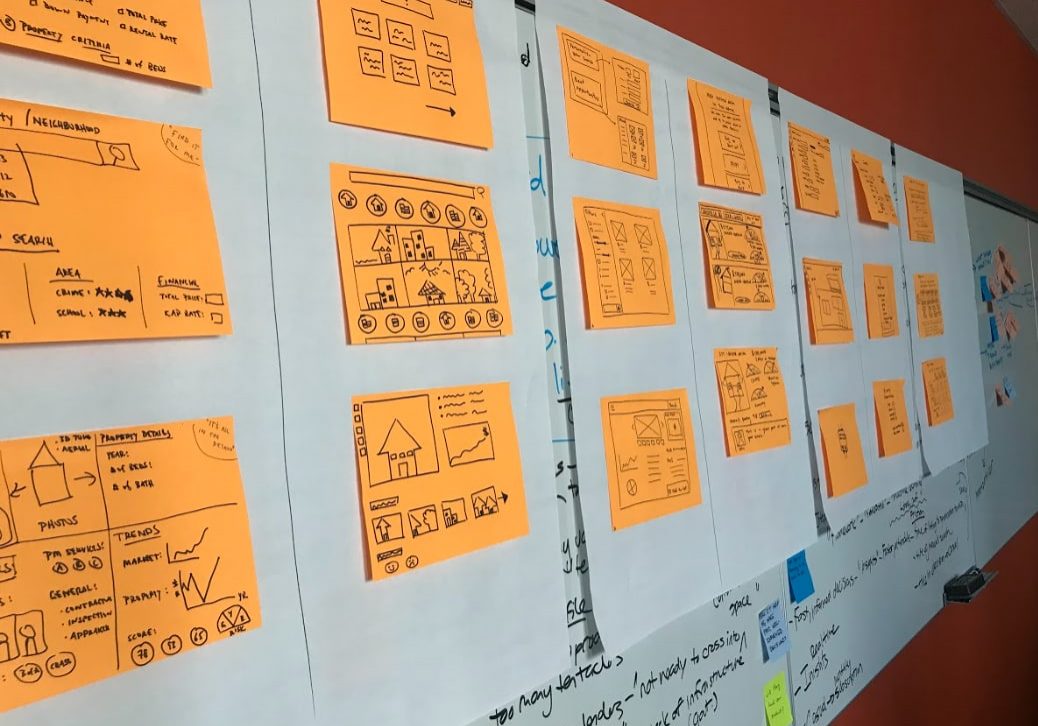
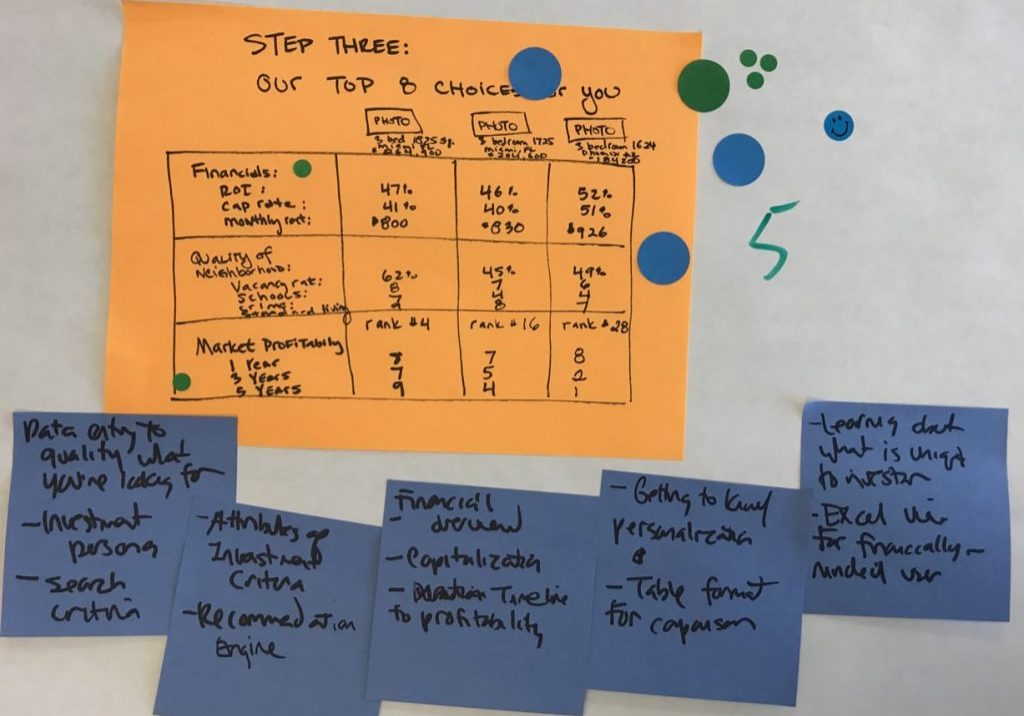
User Flow
After our Design Sprint workshop, we created a user flow which is a visual representation of the path a user will follow in order to achieve a goal. We decided to concentrate on the flow of a user searching and ultimately purchasing a property.

Sketches (Paper Wireframes)
Our team decided to initially sketch individually and went through a few rounds of iteration. Below are some examples:
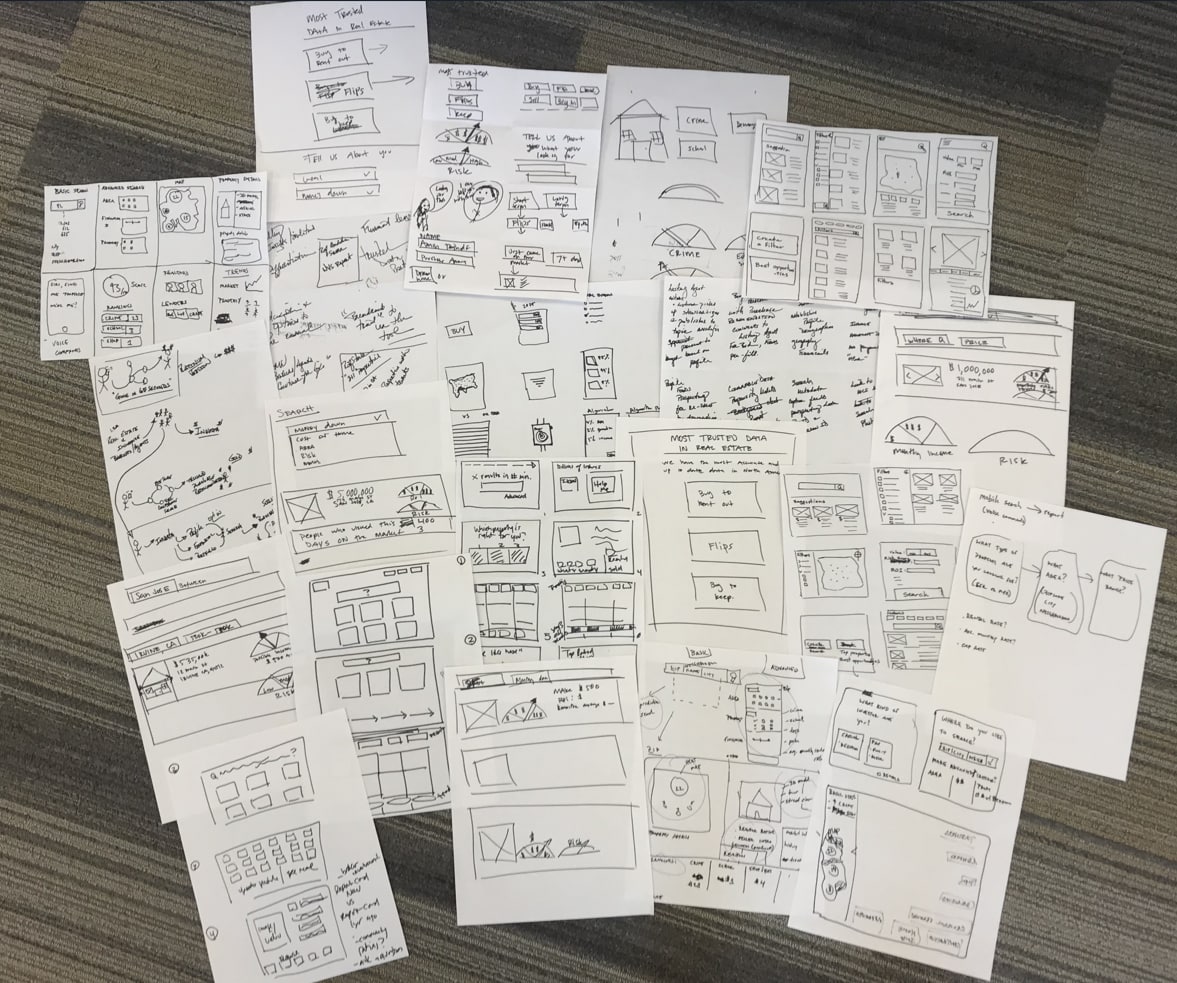
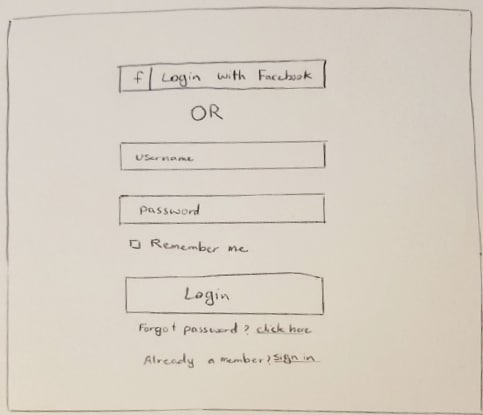
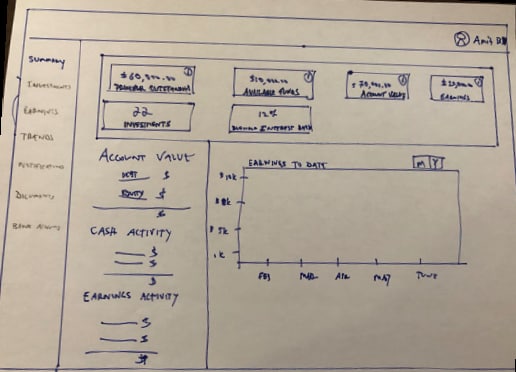
High Fidelity Wireframes
After discussing our sketches internally, we converted the sketches into high fidelity wireframes of certain screens. This allowed us to visually experience the look and feel as well as provide
Portfolio
- Dashboard offering high level snapshot of key KPIs
- Visualization of financial trends
- Updates on new investment opportunities

Create Search Criteria
- Ability to personalize search criteria
- Ability to control ranking of listings
- Key KPIs exposed to make browsing faster
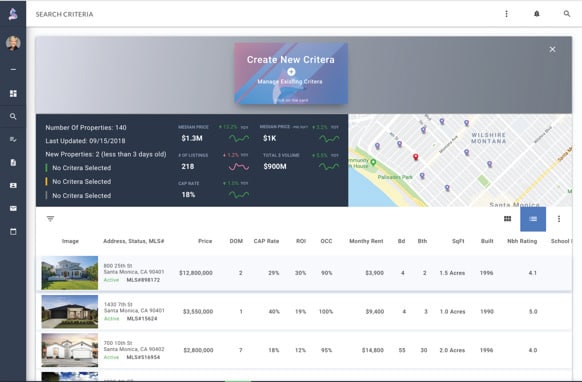
Refine Criteria
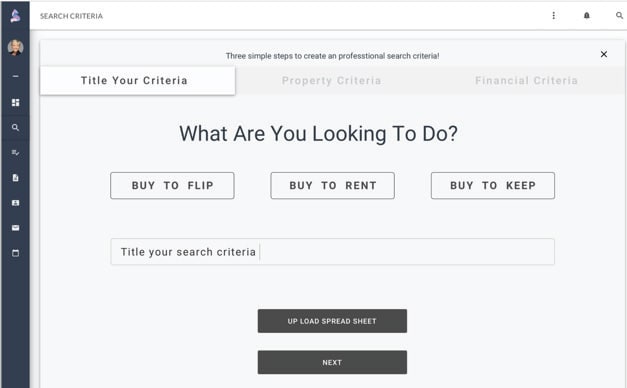
Property Criteria
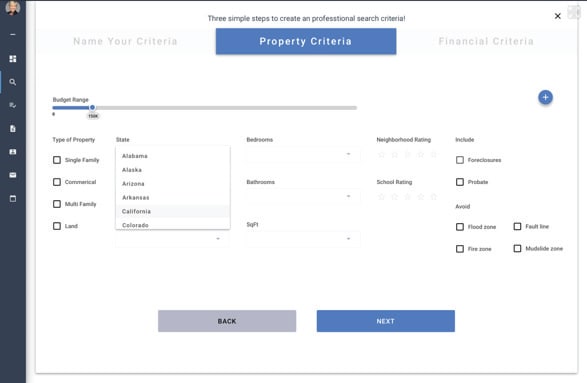
Search Results
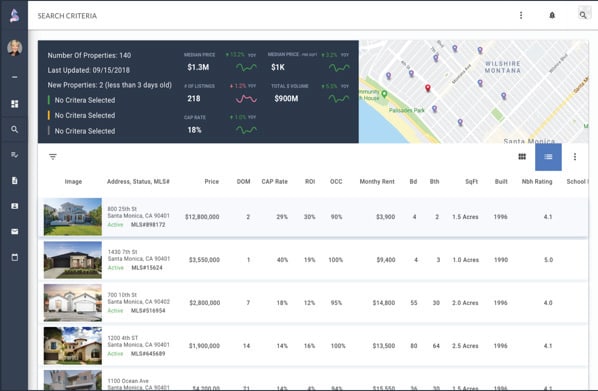
Property Detail

Usability Testing
We performed usability testing with usability experts and received a great amount of feedback. Some key observations were unclear data points, some more relevant than others as well as positive feedback regarding aesthetics.
Client Feedback
Portfolio
“Consider having a section that displays each property a user owns on this page.”
“That would be nice if you could break it down to vacancy, maintenance, taxes.”
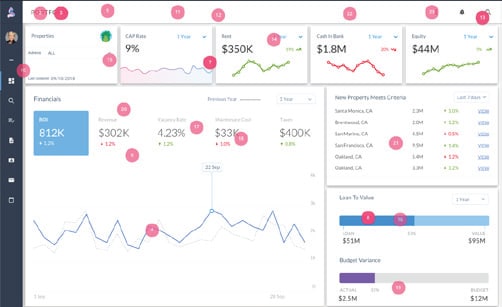
Search
“Is this my all in budget? out of pocket budget? Is this a range ? (is it the maximum, min or range)”
“I’m not sure what this plus sign means.”
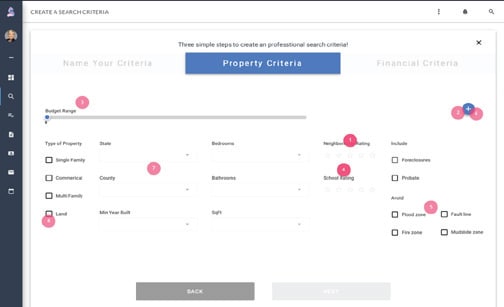
Search Results
“I like that, price per square foot is really important, so i know the bench mark in that area”
“Consider adding a CoreLogic Score.”
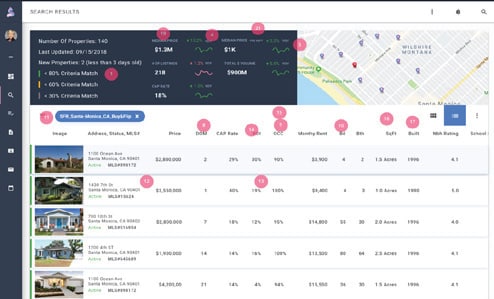
Property Details
“What does purchase mean? Does that mean send an offer? Express your interest to the seller?”
“I would like to manipulate these numbers, what if I want to be conservative or I think I can get more rent”
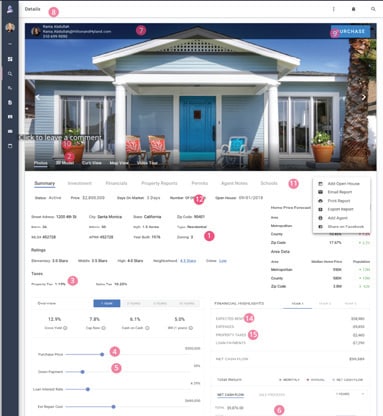
Final Design
Design Considerations
Portfolio
Instead of showing the sales for the month we display the properties the investor has in their portfolio to get get quick access to the individual health of each property.
Replaced revenue data point with CAP rate. During user interview it was mentioned several times this is more important that sales especially for a casual investor.
Data points 3-5 were placed at the top of the page after receiving feedback about the importance of these data points.
Added Vacancy Rate, Maintenance Cost and Taxes in the graphical view rather than having them outside the major graph area.
Replaced revenue and spending to loan and value so that the investor had a good representation of what their burn rate is and profit ratio based off the equity.
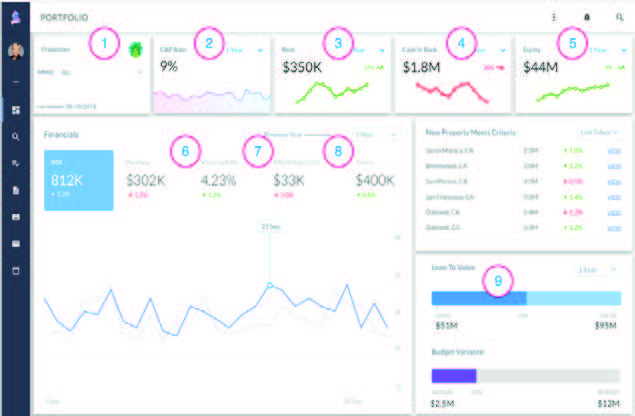
Search
Included the ability to save search criteria and search and find older searched items.
Added the ability to remove and move your saved searches.
Moved the “new search” on the right side of the page
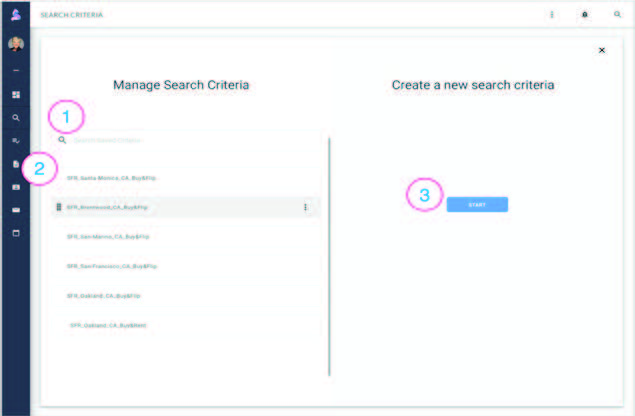
Login / Sign-up
Search
